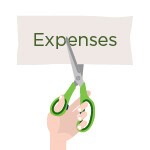How to Manage Cash Flow When Intakes Are Down

Law firms need steady cash flow to operate successfully – even in good times. And in times of economic crisis, it becomes even more critical to manage your cash flow strategically. If your intakes are taking a hit, you need to protect your firm by taking a hard look at how cash is flowing in and out of your firm.
As the Vice President of Administration of one of the most successful PI firms in the Southeast, strategic cash flow management is one of my top priorities. Back in 2010, our firm led one of the largest civil rights cases in the U.S. (In re Black Farmers Discrimination Litigation). Cash flow that was normally used to keep firm intakes healthy was funneled towards financing this epic battle. I had to help figure out how to keep the ship afloat and moving forward so that the firm could focus on helping Black farmers who were fighting years of discrimination by the U.S. government. The stakes were high, but we prevailed – the case culminated in a $1.25 billion settlement for tens of thousands of Black farmers, and we survived to fight another day.
I revisited several of the strategies we employed during that time when COVID-19 hit the U.S., and law firms everywhere experienced declining intakes. We planned proactively, and we were implementing our remote workforce action plan even before March of 2020 when the government enforced a stay-at-home order in our state. And because of this, we were able to continue protecting our clients’ rights throughout the pandemic.
In this article, I will share these cash flow management strategies with you, but I will tell you upfront, it’s not rocket science. One of the main takeaways lessons I learned was to be prepared. You need to be thinking about and planning ahead for the next time your firm’s intakes take a hit – for whatever reason. There’s a reason firefighters keep their boots next to the truck…
Step 1 – Evaluate and Investigate Expenses
If your intakes are declining or your cash flow is restricted for another reason, the first thing you should do is take a long hard look at your costs. This means going line-by-line go through your P&L and looking at all of your expenses – fixed and variable – and assessing their importance to the day-to-day operations of your firm. After you assess and prioritize them, you will need to identify alternate tactics for dealing with them.
 Fixed costs are expenses that remain the same regardless of firm performance, such as lease or mortgage payments, insurance premiums, interest payments, phone and utility bills, and full-time staff salaries. Dig into these expenses. Just because they are fixed, it does not mean that they can’t be touched.
Fixed costs are expenses that remain the same regardless of firm performance, such as lease or mortgage payments, insurance premiums, interest payments, phone and utility bills, and full-time staff salaries. Dig into these expenses. Just because they are fixed, it does not mean that they can’t be touched.
Variable costs are expenses that are related to firm activity which increase as intakes improve and decrease when intakes are down. Variable costs are not set in stone and can generally by adjusted. Variable costs, such as travel, entertainment, employee benefits, supplies, marketing, and part-time staff salaries, are usually the first place to look for cost reductions in the near term.
Step 2 – Act: Reduce, Renegotiate, Reallocate, Review, and Reassess
Once you have identified and prioritized your expenses, it’s time to act. For each line item identified in Step 1, determine possible methods to trim that number down. I have listed below several of the options a law firm should consider for reducing expenses to free up cash flow:
 Reduce expenses
Reduce expenses
First look at temporarily cutting expendable P&L items such as employee outings, celebratory events, travel and entertainment, recruitment, and training. These are the obvious, and easier, cuts.
Another area to consider for cost savings is employee benefits. During the pandemic, it was important to my firm to maintain health insurance benefits for our employees, but we did temporarily cancel our 401-K match plan. We communicated this as a temporary action to our team, and we reinstated it as soon as we felt it was fiscally responsible to do so.
Communication is key here – everyone tends to get nervous when intakes are down, but if you are transparent and explain what cost reductions you are taking and why, you can build trust and nurture a “we’re in it together” team culture.
Renegotiate Contracts and Leases
Whether it’s with your landlord, ISP provider, or bank, dig deep and use those negotiation skills.
 Review your office lease(s). Reduce excess space through tactics such as sub-leasing underutilized space or renegotiating the lease and asking for concessions in exchange for long-term lease renewals. Landlords may be fearful of losing you altogether, so use that as leverage.
Review your office lease(s). Reduce excess space through tactics such as sub-leasing underutilized space or renegotiating the lease and asking for concessions in exchange for long-term lease renewals. Landlords may be fearful of losing you altogether, so use that as leverage.- Scrutinize your telephone and Internet service provider bills and ask for better terms. Often these companies are prepared to agree to more favorable terms in order to build or keep a long-lasting relationship. Look at your current purchasing agreements with all the vendors you purchase or lease from on a regular basis, such as your paper supplier or the copier company, and ask about discounts or promotions.
- Consider asking for a lower rate on your loan agreements or for an extended line of credit. Actively engage with your bank to ensure that your line(s) of credit remain available and to also explore new avenues of cash.
- See if you can work out new marketing contracts. If you advertise on TV or the radio, negotiate with the network or station. Try to obtain a better rate with an annual or longer-term commitment. They may be motivated to avoid a cancelled contract.
And remember: You don’t get what you don’t ask for.
Reallocate Talent
 I deliberately used the word “reallocate” versus “reduce” here. Downsizing can have long-term negative consequences on your firm in terms of revenue, culture, and talent management, and I suggest that you consider it as a last resort only.
I deliberately used the word “reallocate” versus “reduce” here. Downsizing can have long-term negative consequences on your firm in terms of revenue, culture, and talent management, and I suggest that you consider it as a last resort only.
When the pandemic hit, my firm focused instead on reallocating talent – we brought out those ignored-but-needed departmental task wish lists and focused employee efforts on finally tackling those. We reassigned employees whose primary responsibilities were negatively impacted by the pandemic, such as accident investigators and call center employees, to other projects that needed attention. We did not want to lose talent that we’d need to hire back in a few months, so we worked hard to find meaningful work for all that would benefit the firm.
However, I am also a proponent of “trimming the fat” and eliminating unproductive and unresponsive employees who are not helping the firm fulfill its goals. If you have employees who are not pulling their weight, even after focused training and development efforts, bidding them farewell can help your cash flow.
Review Outsourcing Opportunities
 A different tactic regarding employee-related costs involves exchanging certain in-house labor costs for outsourced talent. Explore whether you have any full-time employees who would rather work as independent contractors for your firm – this would save you benefit expenses. Consider the following: Would it be less expensive to outsource your IT labor or your copy services? What about hiring an SEO company on a monthly basis or hiring independent contractors to write your website content?
A different tactic regarding employee-related costs involves exchanging certain in-house labor costs for outsourced talent. Explore whether you have any full-time employees who would rather work as independent contractors for your firm – this would save you benefit expenses. Consider the following: Would it be less expensive to outsource your IT labor or your copy services? What about hiring an SEO company on a monthly basis or hiring independent contractors to write your website content?
I caution you to take a long-term approach here, as well. Look at the situation from all angles. Outsourcing could be a viable expense reduction exercise, but alternatively, you could also possibly reassign outsourced work to those employees whose jobs have been negatively impacted by the slowdown – and reduce outsourcing expenses at the same time.
Reassess Remote Possibilities
 I mentioned earlier that we were ready when the government issued its stay-at-home order during the pandemic. We knew we needed to be fully functional and actively engaged, and we wanted to reassure our clients that we were there for them.
I mentioned earlier that we were ready when the government issued its stay-at-home order during the pandemic. We knew we needed to be fully functional and actively engaged, and we wanted to reassure our clients that we were there for them.
Our transition to a mostly remote workforce was made seamless because of our reliance on the GrowPath case management system. The software allowed our managers to identify bottlenecks and highlighted upcoming deadlines for their employees – no matter where they were. It’s all-in-one platform and cloud technology meant that remote prints were sent and notes were made to files – everything was visible to all, and no client was left behind! And we were able to track remote paralegal and attorney productivity and compare it to their in-office levels. Our team was able to meet the needs of our clients from the get-go.
While the initial investment for enabling your workforce to work remotely can be high (i.e. making sure you have the server bandwidth and equipment), this can be a significant cost-cutting play in the long-term with cost savings generated through reduced office space and employee turnover.
Step 3 – Think Big Picture
In both of the extreme cash flow crunches my firm weathered – during the Black Farmers case and the pandemic – I spent time and energy  taking a step back and looking at the big picture. I engaged in a lot of scenario planning and financial modeling so that we understood how much cash we’d need and for how long. I wanted to be sure we were always able to serve our clients so I looked at what and where we would have to cut back at various revenue levels. And the rest of the management team did this, too. We had to reconsider, and sometimes delay, entering a new market and spending brand-building dollars. We had to postpone larger investments while keeping in mind what we needed to maintain a competitive advantage.
taking a step back and looking at the big picture. I engaged in a lot of scenario planning and financial modeling so that we understood how much cash we’d need and for how long. I wanted to be sure we were always able to serve our clients so I looked at what and where we would have to cut back at various revenue levels. And the rest of the management team did this, too. We had to reconsider, and sometimes delay, entering a new market and spending brand-building dollars. We had to postpone larger investments while keeping in mind what we needed to maintain a competitive advantage.
It’s all about being prepared, being prudent, and being proactive.
Take a look at six other (proven!) ways to combat declining intake calls in the new normal.
